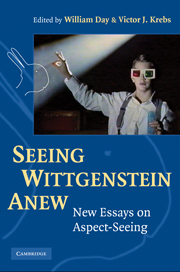Book contents
- Frontmatter
- Contents
- List of Contributors
- Acknowledgments
- Abbreviations of Wittgenstein's Works
- Seeing Wittgenstein Anew
- Introduction: Seeing Aspects in Wittgenstein
- I ASPECTS OF “SEEING-AS”
- 1 Aesthetic Analogies
- 2 Aspects, Sense, and Perception
- 3 An Allegory of Affinities
- 4 The Touch of Words
- II ASPECTS AND THE SELF
- III ASPECTS AND LANGUAGE
- IV ASPECTS AND METHOD
- Appendix: A Page Concordance for Unnumbered Remarks in Philosophical Investigations
- List of Works Cited
- Index
3 - An Allegory of Affinities
On Seeing a World of Aspects in a Universe of Things
Published online by Cambridge University Press: 05 June 2012
- Frontmatter
- Contents
- List of Contributors
- Acknowledgments
- Abbreviations of Wittgenstein's Works
- Seeing Wittgenstein Anew
- Introduction: Seeing Aspects in Wittgenstein
- I ASPECTS OF “SEEING-AS”
- 1 Aesthetic Analogies
- 2 Aspects, Sense, and Perception
- 3 An Allegory of Affinities
- 4 The Touch of Words
- II ASPECTS AND THE SELF
- III ASPECTS AND LANGUAGE
- IV ASPECTS AND METHOD
- Appendix: A Page Concordance for Unnumbered Remarks in Philosophical Investigations
- List of Works Cited
- Index
Summary
For many years, there has been a sharp division between two approaches to Wittgenstein's discussion of seeing aspects and the other topics in Part II, Section 11 of Philosophical Investigations. However rough my description of this division, we can discern a difference between those commentators who have addressed the question of aspects as primarily concerned with the “psychology” of perception, and those who have tended to think of the topic as involved in larger issues of interpretation or aesthetics.
Useful work has been done under the sway of both approaches. It certainly cannot be denied that Wittgenstein is trying to puzzle out issues about, among other things, the conceptual intersection of seeing and thinking and interpreting (construed here as “seeing something as something”). Taken at face value, these are hardly an intellectually restrictive set of concerns, and they place Wittgenstein in a lineage of investigation that contains such thinkers as Merleau-Ponty and the Gestalt psychologists. But it is equally clear that Wittgenstein makes some bold conceptual jumps from questions of seeing aspects, to questions of “experiencing the meaning of a word,” to questions about “primary” and “secondary” senses of words. His way of drawing connections within this set of problems and interests has little precedent. And it is this set of connections among his interests that has, I believe, drawn philosophers into searching for an underlying scheme or intention that will display the unity of these passages.
- Type
- Chapter
- Information
- Seeing Wittgenstein Anew , pp. 61 - 80Publisher: Cambridge University PressPrint publication year: 2010
- 2
- Cited by

